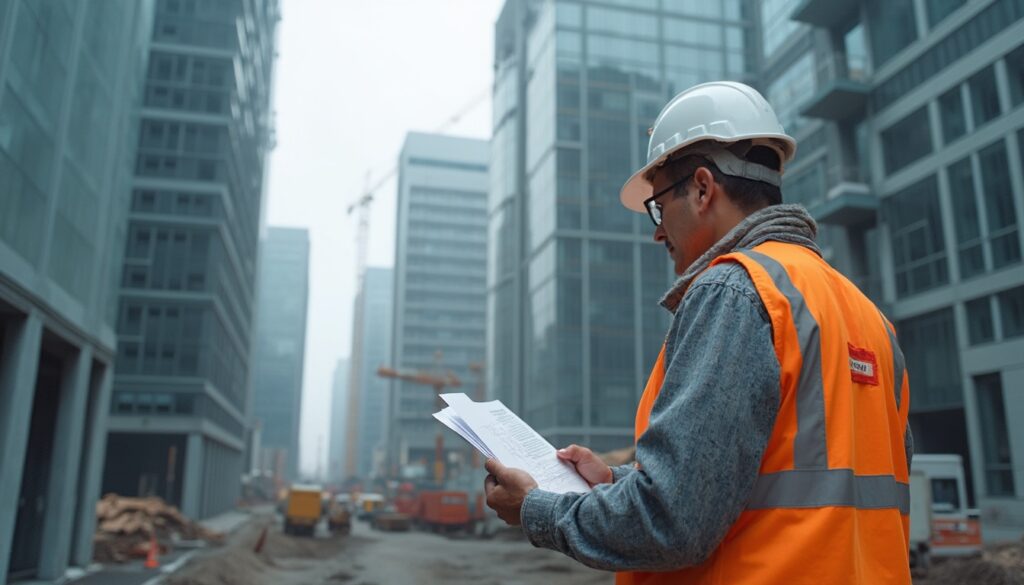Mastering the Legal Handover: Your Checklist for Safe Building Without Unpleasant Surprises
Hand on heart: The legal handover is a moment in the construction process that truly matters. This is about the official transfer of responsibility – the accountability shifts from the contractor to you as the client. And that carries significant legal weight. To avoid costly surprises later on, excellent preparation and execution with a detailed legal handover checklist is worth its weight in gold. In this article, we take you by the hand and cover everything essential: from the legal basics to proper preparation and detailed documentation. We show you how to navigate this process smoothly with the right approach – and clever digital helpers such as our digital checklist app for construction – to help you sail through and avoid typical pitfalls. Our goal? To provide you with everything you need to ensure your construction project is a resounding success and stands on legally solid ground. legal handover checklist mitzugeben, damit Ihr Bauprojekt ein voller Erfolg wird und rechtlich auf sicheren Füßen steht.
- The legal handover marks the official transfer of responsibility from the contractor to the client.
- A detailed legal handover checklist checklist is crucial for avoiding expensive surprises and ensuring a smooth process.
- There are various types of handover: the legal, technical, and official handover, each with its own rules that a good legal handover checklist covers.
- This article provides a comprehensive guide and a legal handover checklist framework for a successful legal handover.
It’s important to know that there isn’t just *one* handover. We are talking about the legal, technical, and official handovers. It may sound like a lot at first, but don’t worry, it’s not that complicated. Each has its own rules and consequences that you as a client, as well as the contractor, should be aware of. The legal handover focuses on what the contract states. The technical handover examines in detail whether everything has been built without defects and professionally. And the official handover? It checks whether your structure complies with the building permit and the official regulations. A really good legal handover checklist checklist covers all these points.The legal compass for your construction handover: BGB, VOB, and the various types of handovers explained.
To ensure everything goes legally during the handover, there are clear rules. We primarily find them in the Civil Code (BGB) and the German Construction Contract Procedures (VOB/B). If you are building privately, the BGB is usually your anchor, specifically § 640 BGB, which regulates your obligation for the handover. The VOB/B comes into play more often with public or larger projects and has precise stipulations for the handover in § 12, including deadlines and specific forms such as the formal handover. The essential difference often lies in the fact that the VOB/B is somewhat stricter regarding formalities and sets shorter deadlines. But regardless of which legal framework applies: Both make clear how important the handover is for the transfer of risks (risk transfer), the start of the warranty period, and the payment of the invoice. A savvy legal handover checklist checklist always keeps in mind what exactly is stated in your contract.
- The legal foundations of the construction handover can be found in the BGB (§ 640) and the VOB/B (§ 12), with the VOB/B often having stricter formalities; a good legal handover checklist checklist takes this into account.
- The handover is crucial for the risk transfer, the commencement of the warranty period, and the due date of the final invoice, points that every legal handover checklist checklist should encompass.
- One distinguishes the legal handover (contractual fulfillment), technical handover (defect-free), and official handover (compliance with permits).
- A construction project is considered ready for handover when it is essentially free of defects and completed per contract, which your legal handover checklist should confirm.
Understanding the different types of construction handover
So, what exactly is behind the different types of handover? The legal handover is basically your declaration as the client: ‘Yes, the work is as we agreed in the contract – at least essentially.’ You can state this clearly or show it through your actions (implicitly, as lawyers say). The technical handover technical handover is the critical examination of quality: Is everything defect-free and built according to recognized standards? It’s often worth having an independent construction expert official handover, sometimes also called the final handover. This is performed by the building office and checks whether everything complies with the building permit and laws such as the state building regulations. Important: This is not the same as the handover between you and the contractor, but without it, you often can’t legally use your building. A well-thought-out legal handover checklist checklist helps you keep everything under control.
When is a building considered ‘ready for handover’? Quite simply: When it is generally defect-free and everything has been done as agreed in the contract. Minor cosmetic issues or insignificant defects are usually not grounds to reject the handover – but they must be included in the handover report according to VOB, an important part of your legal handover checklist. Typically, the contractor notifies when they are finished (this is called completion notification). Then it’s your turn as the client for the handover, provided everything is indeed ready for it. Your legal handover checklist checklist should help you verify this precisely. The checklist is really a crucial point in contract law that your legal handover checklist must consider.Good planning is half the battle: How to optimally prepare your construction handover – documents, planning, and expert advice
Good preparation is truly the A and O for a stress-free construction handover. This allows you to confidently tick off your legal handover checklist points one by one. At the top of the to-do list is: gather all essential documents. Because without the right papers, it’s hard to seriously check if everything was built as it should be. So make sure you have all plans, contracts, and evidence ready, as your legal handover checklist checklist should specify. Only then can the exact comparison of actual vs. required be successful. If you have relied on a comprehensive digital construction documentation , you will naturally find it considerably easier now.
Necessary documents and materials for your checklist
So that you have everything in view during the handover and your legal handover checklist is complete, you need a few key documents. These are basically your foundation for assessing the construction execution:
- Construction contract and detailed construction description: These define the required scope of performance and are the basis for your legal handover checklist.
- Building permit and relevant development plans: Important for official compliance.
- Execution plans, working drawings, and detail drawings: Basis for the technical examination.
- Specifications and selection protocols: For kitchen, sanitary, electrical, floor, and wall coverings.
- Proofs: Structural calculations and energy certificates.
- Protocols: Von Construction meetings and previous defect notifications.
- Guarantee documents and instructions: For devices and materials.
- Soil assessments: Relevant for foundation and earthworks.
The organization of the handover date also needs to be well planned. Coordinate the date precisely with everyone who must be present (contractor, architect, possibly also specialist planners and experts). Consider a clear schedule in advance and who is responsible for what. And very importantly: Ensure that everything necessary is ready on the big day – camera, measuring tape, spirit level, and something to write with (or a practical digital checklist app). A clean plan, ideally with a good legal handover checklist in tow, reduces a lot of stress and prevents trouble. Often, it’s also a good idea to bring in an independent construction expert. Such an expert has an eye for hidden defects that you might overlook as a layperson and can professionally evaluate whether everything has been built according to the rules of technology. The costs for this are usually well-invested money, considering what undiscovered defects can cost later on. Additionally, the expert serves as an important witness and can help you formulate the handover report watertight – a perfect addition to your legal handover checklist.Now it’s time for the essentials: Systematically conducting the construction handover – walkthrough and quality check in detail
When the day of the handover arrives, it’s about systematically and thoroughly inspecting the entire building. Your legal handover checklist checklist is your best friend and guide to ensure that you don’t overlook anything. Start outside and then work your way through the house room by room. A clearly structured checklist, ideally led by your legal handover checklistconstruction expert, is really important here. Don’t just look at what immediately catches your eye, but also test whether all installations and fittings work. The comparison with the plans and the construction description – that is, the actual vs. required comparison – is super important. You see: Good preparation with a detailed legal handover checklist checklist really pays off now.
Systematic walkthrough of the building: Exterior and interior
It’s best to proceed systematically during the walkthrough. Your legal handover checklist checklist should help you remember the following areas:
- Exterior: Check the facade (cracks, plaster, coating), roof (covering, insulation, drainage), windows and exterior doors (tightness, operability, fittings), balconies/terraces, access paths, and possibly exterior facilities.
- Interior (room by room): Inspect floor coverings (unevenness, joints, damage), walls and ceilings (surface quality, paint, wallpaper), interior doors (closing behavior, frames).
- Installations: Function test of electrical installations (switches, sockets, fuses), sanitary installations (water flow, tightness, fittings), and heating systems (function, regulation).
- Other areas: Stairs (safety, steps), basement (moisture, sealing), attic (insulation, ventilation) – all these are points for your legal handover checklist.
In the quality check, it’s about more than just a quick glance. Assess the materials and how they were processed with a critical eye. Do they match what was agreed upon and comply with recognized standards? Is everything functional and easy to operate? This also includes checking whether technical standards (such as DIN standards) and guidelines have been followed. Additionally, safety aspects such as fire protection, escape routes, and fall protection are critical points on your legal handover checklist. Everything you notice – every deviation, every defect – must be documented precisely. Take photos and describe each defect as detailed as possible. This documentation, preferably supported by a digital defect recording system and as part of your legal handover checklist, is the basis for your handover report and if you later need to assert warranty claims.Black on white: Why the handover report is crucial for your legal security
The handover report – this is truly the heart of the construction handover and an absolute must if you want to handle your legal handover checklist professionally. It documents in black and white the condition of your structure at the time of the handover and records all agreements, defects, and deadlines. A clean and comprehensive report provides both parties – you and the contractor – with legal security and is an important piece of evidence should conflicts arise later on. That’s why it’s super important that all points are accurately recorded. With, which are often part of a comprehensive legal handover checklist software solution, you can contribute to greater accuracy and completeness here.
- The handover report, as the centerpiece of your legal handover checklist, is the central document for legal security and serves as important evidence.
- It documents the condition of the building, all defects, agreements, and deadlines for remedying defects.
- Key contents include information about participants, contract details, findings regarding performance, a detailed list of defects, and signatures – all elements of a thorough legal handover checklist.
- With the signature, the warranty period begins and the burden of proof shifts; it also allows for withholding payments in case of defects.
Key contents of the handover report
A handover report that is well-prepared and reflects the result of your careful legal handover checklist should at least contain the following information:
- General data: Names and addresses of all participants (client, contractor, architect, expert), date and place of the handover.
- Contract details: Order number, contract date, exact designation of the construction project.
- Performance data: Date of commencement and (notified) completion of the construction work.
- Subject of handover: Clear naming of the construction services or trades to be handed over.
- Findings: Explanation regarding performance fulfillment (handed over/not handed over/conditionally handed over).
- Defect list: Detailed listing of all identified defects with exact location and description, a central point of every legal handover checklist.
- Deadline setting: Binding deadlines for remedying the documented defects.
- Reservations: Any reservations from the client regarding known defects or contractual penalties.
- Other agreements: E.g. regulations regarding remaining work, usage restrictions.
- Signatures: From all parties involved in the handover.
Don’t underestimate how important the handover report is from a legal standpoint! As soon as you sign, the warranty period starts – usually lasting five years (according to BGB). Simultaneously, the burden of proof shifts, an aspect that your legal handover checklist checklist should highlight: If defects arise after the handover, you as the client must prove that the defect existed at the time of the handover or was caused by a contractor’s error. If defects are recorded in the report, the contractor must rectify them within the agreed deadline. And here’s an important point: According to § 641 Abs. 3 BGB, you may withhold a portion of the payment (usually double the estimated costs of remedying the defects) until everything is resolved. This is a strong argument that your legal handover checklist should definitely keep in mind.Not everyday, but important: Special cases in the construction handover – from official inspections to partial services
In addition to the ‘normal’ handover between you and the contractor, there are also a few special cases that you should note on your legal handover checklist checklist. For example, the official handover by the building authority. They primarily check whether your new building complies with the building permit and the regulations of the state building code. This is about the official, public law side – not whether everything is perfect according to the construction contract. Such a handover is often necessary for you to officially use your building. If something is amiss, it can be costly or, in the worst case, may even mean that something has to be demolished – a risk that a good legal handover checklist checklist helps to minimize.
Also very important: the handover of your exhaust system (for example the chimney for the fireplace or the heating) by the district chimney sweep. They check to ensure everything is safe and functional. They examine whether the system is properly sized, sufficient air is available for combustion, the exhaust gases are safely vented, and fire safety measures are in place. Without a green light from the chimney sweep, you aren’t allowed to use your heating appliance. If this applies to you, this point definitely belongs on your legal handover checklist. The certificates from these inspections are, by the way, important documents that you should keep well and mark as completed in your legal handover checklist checklist.
Sometimes, a handover of partial services occurs. This can happen if a construction contract is terminated earlier than planned or if you agreed in the contract that certain construction phases or trades are to be handed over individually. If the contract is terminated, you as the client must accept the performance rendered up to that point – provided that it is essentially acceptable. The state of affairs at the time of termination is then evaluated. Here too: Accurate documentation and a report, ideally with a specific legal handover checklist checklist for partial services, are extremely important for legal clarification and what happens next. The Additional and defect management according to VOB/B often has precise regulations that your legal handover checklist checklist should consider.Avoiding pitfalls: How to minimize risks during the construction handover and avoid typical mistakes
One risk that many underestimate during the handover is the so-called implicit acceptance. It sounds complicated, but simply means: You can unintentionally declare acceptance through certain actions without an official report. A typical example: You move into the house or pay the final invoice without raising any objections. Legally, this can be interpreted as accepting the service, a pitfall that a careful legal handover checklist checklist is meant to prevent. This makes it much harder to assert defects later on. Your legal handover checklist checklist should therefore remind you: Do not create completed facts before the formal acceptance is done and all defects are clarified. Always be aware of the
consequences. legal handover checklist checklist. And if there are defects: explicitly and substantively refuse acceptance with reasons! A good legal handover checklist checklist helps you keep these deadlines in mind.
And what if defects arise after acceptance or you have overlooked something? Then it’s time to act quickly! Document the defect immediately in writing (this is called a defect notice) and give the contractor a reasonable timeframe to rectify it. Describe the defect as precisely as possible, ideally referencing points from your original legal handover checklistchecklist. If the contractor does not respond or does not rectify the defect properly, you have further options: You can have the defect remedied yourself and claim the costs, pay less, or even demand damages in some cases. How to proceed best should be part of your strategy in the defect management and can already be prepared with a good legal handover checklist checklist.Digitalization makes it easier: How software makes your construction handover more efficient
Digitalization is a true game-changer, even in the construction handover and when it comes to making your legal handover checklist process more efficient and transparent. With modern construction software, you can digitally document the entire process from planning to handover. This means: Plans, contracts, reports, and photos are all stored in one place. During the handover itself, you can record defects directly in digital form on-site, based on your digital legal handover checklistchecklist, add photos, and assign responsibilities and deadlines. This not only saves paperwork but also avoids errors when transferring information and makes everything traceable. This is exactly what we at Valoon GmbH aim to achieve with our software solutions: simplifying these processes and improving communication between all those involved in construction.
Mobile apps for the construction site, like our construction log app, are another important helper. This allows construction managers and experts to go through the legal handover checklist directly on the tablet or smartphone. Defects are immediately recorded, with all important information (photo, location, description, urgent level), and the data is available in real-time for everyone who needs it. This not only speeds up defect recording but also the entire defect managementprocess, as each point of the legal handover checklist can be tracked digitally. If messenger services are also integrated, as we provide at Valoon, direct communication with people on-site works even better.
The advantages that digitalization brings to the construction process are really diverse. You not only save time and work more efficiently, but digital tools also enhance communication and collaboration among all those involved in the project. Everything becomes more transparent because all important information is centrally and always current. Especially when you are creating and working through a legal handover checklist checklist, this is a huge benefit. Mistakes happen less frequently, and the construction documentation, including the final legal handover checklist, simply improves. In the long run, digitalization helps make construction projects more successful and economical – an important step forward, especially in a traditional industry like construction.On the safe side: Your conclusion for a successful construction handover and our tips for you
To summarize: A construction handover that is carefully prepared and carried out – ideally with a comprehensive legal handover checklist checklist at your side – is essential for ensuring that your construction project is legally concluded. The handover report is your most important piece of evidence: It records how the building looked and serves as the basis for your warranty claims. Since this whole process can be quite complex and often involves a lot of money, it is highly advisable to enlist an independent construction expert. They have the know-how to identify defects early and protect your interests as a client, especially when creating and executing the legal handover checklisthandover report. Investing time in this checklist is definitely worthwhile in the long run. legal handover checklist The construction industry is constantly evolving – new technologies and higher demands for quality and sustainability are driving change. Digitalization plays a significant role in this and will continue to alter the processes surrounding the construction handover and the associated
Die Baubranche ist ständig in Bewegung – neue Technologien, höhere Ansprüche an Qualität und Nachhaltigkeit treiben den Wandel voran. Die Digitalisierung spielt dabei eine ganz große Rolle und wird auch die Abläufe rund um die Bauabnahme und die dazugehörige legal handover checklist requirements. Digital tools for defect recording, construction documentation, and communication, like those we develop at Valoon GmbH, are becoming increasingly common. They help work more efficiently, avoid errors, and improve collaboration among all participants. Therefore, our advice for clients and construction companies: Engage with these developments early and make use of the benefits of digital helpers for your projects. This way, you can optimally manage every legal handover checklist construction project.
To ensure everything runs smoothly, we recommend: Talk early and openly with all stakeholders. A seamless documentation from the start, preferably with digital tools, ensures transparency and prevents misunderstandings. And of course, it is clear that everything important is carefully documented during the acceptance process. A conscientious execution of legal handover checklist is truly the key to the success of your construction project and gives you legal security. With the right preparation, a precise documentation that also includes your legal handover checklist and perhaps some expert assistance, you can minimize risks and look forward to a worry-free time in your new property. Do you want to know how we at Valoon GmbH can support you with our innovative software solutions in the defect management and with the digital construction documentation ? Then just contact us for a personalized consultation! We would be happy to show you how we can make your project management easier!
Why is a detailed checklist so crucial for the construction-related acceptance?
A checklist ensures that all contractual services are reviewed, defects are systematically recorded and the acceptance protocol is complete. This significantly minimizes risks and future disputes.
What are the biggest mistakes I should avoid during construction acceptance?
The biggest mistakes are insufficient preparation, overlooking defects, a deficient acceptance protocol, and actions that could be interpreted as tacit acceptance (e.g., moving in or full payment without reservation). When is a construction expert really useful during acceptance? (z.B. Einzug oder vollständige Zahlung ohne Vorbehalt) gewertet werden könnten.
Wann ist ein Bausachverständiger bei der Abnahme wirklich sinnvoll?
An expert is particularly recommended for complex construction projects, to identify hidden defects , or in case of uncertainties. Their expertise can save significant subsequent costs and strengthen your position.
What information must not be missing in the acceptance protocol?
Essential are: Participants, date and location, precise designation of the construction project and the services to be accepted, a detailed list of defects (ideally with photos), clear deadlines for defect rectification, and the signatures of all parties.
How can digital tools like construction software simplify the acceptance process?
Digital tools enable an efficient defect capture on site, a seamless photo documentation, the quick creation of protocols, and improved, traceable communication among all parties involved. What happens if I pay the final invoice in full before the formal acceptance?
The full payment without reservation can be regarded as
tacit acceptance (conclusive acceptance). This significantly complicates the assertion of defects as the burden of proof for the existence of the defect during acceptance shifts to you. What is the main difference between technical and official construction acceptance? erheblich, da die Beweislast für das Vorhandensein des Mangels bei Abnahme auf Sie übergeht.
Worin liegt der Hauptunterschied zwischen der technischen und der behördlichen Bauabnahme?
Die technical handover checks the contractual and defect-free execution of construction services by the contractor. The official handover (e.g., by the building authority) controls compliance with the building permit and public law regulations for usage.
Does the warranty period only begin with the signing of the acceptance protocol?
Yes, the statute of limitations for defect claims (warranty period, usually 5 years according to the BGB) generally begins with the legally effective acceptance of the construction work, which is clearly documented by the signed protocol.








